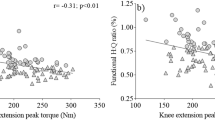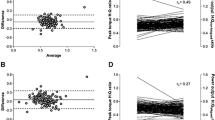Abstract
Background
Running is a very popular activity and muscle strength imbalance has been treated with caution to prevent injuries.
Aim
The present study aimed to compare and correlate knee flexion and extension strength imbalance based on peak torque (PT) and total work (TW) in running athletes.
Methods
Thirty-eight male amateur running athletes (38 ± 6 years; 80.6 ± 8.3 kg; 177 ± 7 cm; 7.8 ± 8.4 years of training; 3.5 ± 0.9 training sessions a week; 33.5 ± 13.4 km of training per week) took part in the present study. Knee flexion eccentric and concentric PT and TW, as well as concentric knee extension PT and TW were assessed. PT- and TW-based hamstring-to-quadriceps ratios (H:Q), as well as PT and TW contralateral imbalance were quantified.
Results
A significant correlation was observed between TW and PT concentric knee flexion contralateral deficits (r = 0.52, p < 0.001). No further correlations were found among TW- and PT-based muscle strength imbalance variables (p > 0.05). All mean comparisons of H:Q and contralateral imbalances using TW or PT were significantly different (p < 0.05).
Conclusions
Our results showed that TW and PT muscle strength imbalance were unrelated, and the H:Q and contralateral imbalance profile of endurance runners may differ based on the isokinetic variable analyzed.

Similar content being viewed by others
References
Hespanhol Junior LC, Pillay JD, van Mechelen W, Verhagen E (2015) Meta-analyses of the effects of habitual running on indices of health in physically inactive adults. Sports Med 45:1455–1468
Francis P, Whatman C, Sheerin K, Hume P, Johnson MI (2019) The proportion of lower limb running injuries by gender, anatomical location and specific pathology: A systematic review. J Sports Sci Med 18:21–31
Martínez-Silván D, Díaz-Ocejo J, Murray A (2017) Predictive indicators of overuse injuries in adolescent endurance athletes. Int J Sports Physiol Perform 12:S2153–S2156
Johnston R, Cahalan R, O’Keeffe M, O’Sullivan K, Comyns T (2018) The associations between training load and baseline characteristics on musculoskeletal injury and pain in endurance sport populations: A systematic review. J Sci Med Sport 21:910–918
Baltich J, Emery CA, Stefanyshyn D, Nigg BM (2014) The effects of isolated ankle strengthening and functional balance training on strength, running mechanics, postural control and injury prevention in novice runners: design of a randomized controlled trial. BMC Musculoskelet Disord 15:407
Dellagrana RA, Diefenthaeler F, Carpes FP, Hernandez SG, de Campos W (2015) Evidence for isokinetic knee torque asymmetries in male long distance-trained runners. Int J Sports Phys Ther 10:514–519
Opar DA, Williams MD, Timmins RG, Hickey J, Duhig SJ, Shield AJ (2015) Eccentric hamstring strength and hamstring injury risk in Australian footballers. Med Sci Sports Exerc 47:857–865
Croisier JL, Ganteaume S, Binet J, Genty M, Ferret JM (2008) Strength imbalances and prevention of hamstring injury in professional soccer players: a prospective study. Am J Sports Med 36:1469–1475
Dauty M, Menu P, Fouasson-Chailloux A, Ferréol S, Dubois C (2016) Prediction of hamstring injury in professional soccer players by isokinetic measurements. Muscles Ligaments Tendons J 6:116–123
Timmins RG, Bourne MN, Shield AJ, Williams MD, Lorenzen C, Opar DA (2016) Short biceps femoris fascicles and eccentric knee flexor weakness increase the risk of hamstring injury in elite football (soccer): a prospective cohort study. Br J Sports Med 50:1524–1535
van Dyk N, Bahr R, Whiteley R, Tol JL, Kumar BD, Hamilton B, Farooq A, Witvrouw E (2016) Hamstring and quadriceps isokinetic strength deficits are weak risk factors for hamstring strain injuries: A 4-year cohort study. Am J Sports Med 44:1789–1795
van Dyk N, Bahr R, Burnett AF, Whiteley R, Bakken A, Mosler A, Farooq A, Witvrouw E (2017) A comprehensive strength testing protocol offers no clinical value in predicting risk of hamstring injury: a prospective cohort study of 413 professional football players. Br J Sports Med 51:1695–1702
Ruas CV, Pinto RS, Hafenstine RW, Pereira MC, Brown LE (2014) Specific joint angle assessment of the shoulder rotators. Isok Exe Sci 22:197–204
Ellenbecker TS, Roetert EP (1999) Testing isokinetic muscular fatigue of shoulder internal and external rotation in elite junior tennis players. J Orthop SportsPhys Ther 29:275–281
Pinto MD, Blazevich AJ, Andersen LL, Mil-Homens P, Pinto RS (2018) Hamstring-to-quadriceps fatigue ratio offers new and different muscle function information than the conventional non-fatigued ratio. Scand J Med Sci Sports 28:282–293
Zebis MK, Andersen LL, Ellingsgaard H, Aagaard P (2011) Rapid hamstring/quadriceps force capacity in male vs. female elite soccer players. J Strength Cond Res 25:1989–1993
Jordan MJ, Aagaard P, Herzog W (2015) Rapid hamstrings/quadriceps strength in ACL-reconstructed elite Alpine ski racers. Med Sci Sports Exerc 47:109–119
Minozzo F, Lopez P, Machado CLF, Wilhelm EN, Grazioli R, Pinto RS (2018) Alternative assessment of knee joint muscle balance of soccer players through total work-based hamstring: quadriceps ratios. Eur J Sport Sci 18:1398–1404
Souza RB (2016) An evidence-based videotaped running biomechanics analysis. Phys Med Rehabil Clin N Am 27:217–236
Johnston JT, Mandelbaum BR, Schub D, Rodeo SA, Matava MJ, Silvers-Granelli HJ, Cole BJ, ElAttrache NS, McAdams TR, Brophy RH (2018) Video analysis of anterior cruciate ligament tears in professional American football athletes. Am J Sports Med 46:862–868
Aagaard P, Simonsen EB, Magnusson SP, Larsson B, Dyhre-Poulsen P (1998) A new concept for isokinetic hamstring: quadriceps muscle strength ratio. Am J Sports Med 26:231–237
Aagaard P, Simonsen EB, Trolle M, Bangsbo J, Klausen K (1995) Isokinetic hamstring/quadriceps strength ratio: influence from joint angular velocity, gravity correction and contraction mode. Acta Physiol Scand 154:421–427
Hopkins WG, Marshall SW, Batterham AM, Hanin J (2009) Progressive statistics for studies in sports medicine and exercise science. Med Sci Sports Exerc 41:3–13
McCall A, Carling C, Nedelec M, Davison M, Le Gall F, Berthoin S, Dupont G (2014) Risk factors, testing and preventative strategies for non-contact injuries in professional football: current perceptions and practices of 44 teams from various premier leagues. Br J Sports Med 48:1352–1357
Maniar N, Schache AG, Sritharan P, Opar DA (2018) Non-knee-spanning muscles contribute to tibiofemoral shear as well as valgus and rotational joint reaction moments during unanticipated sidestep cutting. Sci Rep 8:2501
Zifchock RA, Davis I, Hamill J (2006) Kinetic asymmetry in female runners with and without retrospective tibial stress fractures. J Biomech 39:2792–2797
Zifchock RA, Davis I, Higginson J, McCaw S, Royer T (2008) Side-to-side differences in overuse running injury susceptibility: a retrospective study. Hum Mov Sci 27:888–902
Lin HC, Li JS, Lo SF, Shih YF, Lo CY, Chen SY (2009) Isokinetic characteristics of shoulder rotators in patients with adhesive capsulitis. J Rehabil Med 41:563–568
Fousekis K, Tsepis E, Poulmedis P, Athanasopoulos S, Vagenas G (2011) Intrinsic risk factors of non-contact quadriceps and hamstring strains in soccer: a prospective study of 100 professional players. Br J Sports Med 45:709–714
Bourne MN, Opar DA, Williams MD, Shield AJ (2015) Eccentric knee flexor strength and risk of hamstring injuries in rugby union: a prospective study. Am J Sports Med 43:2663–2670
Delextrat A, Gregory J, Cohen D (2010) The use of the functional H: Q ratio to assess fatigue in soccer. Int J Sports Med 31:192–197
Maupas E, Paysant J, Datie AM, Martinet N, André JM (2002) Functional asymmetries of the lower limbs. A comparison between clinical assessment of laterality, isokinetic evaluation and electrogoniometric monitoring of knees during walking. Gait Posture 16:304–312
Fyfe JJ, Bishop DJ, Stepto NK (2014) Interference between concurrent resistance and endurance exercise: molecular bases and the role of individual training variables. Sports Med 44:743–762
Barnes KR, Kilding AE (2015) Strategies to improve running economy. Sports Med 45:37–56
Saragiotto BF, Yamato TP, Cosialls AMH, Lopes AD (2016) Desequilíbrio muscular dos flexores e extensores do joelho associado ao surgimento de lesão musculoesquelética relacionada à corrida: um estudo de coorte prospectivo. Rev Bras Ciênc Esporte 38:64–68
Kluitenberg B, van Middelkoop M, Diercks R, van der Worp H (2015) What are the differences in injury proportions between different populations of runners? A systematic review and meta-analysis. Sports Med 45:1143–1161
Prodromos CC, Han Y, Rogowski J, Joyce B, Shi K (2007) A meta-analysis of the incidence of anterior cruciate ligament tears as a function of gender, sport, and a knee injury-reduction regimen. Arthroscopy 23:1320–1325
Ahmad CS, Clark AM, Heilmann N, Schoeb JS, Gardner TR, Levine WN (2006) Effect of gender and maturity on quadriceps-to-hamstring strength ratio and anterior cruciate ligament laxity. Am J Sports Med 34:370–374
Acknowledgements
We thank to CAPES and CNPq Brazilian Government Associations for support. We also thank to Universidade de Caxias do Sul and all the running athletes who participated in this research and made it possible.
Author information
Authors and Affiliations
Corresponding author
Ethics declarations
Conflict of interest
No potential conflict of interest was reported by the authors.
Ethical approval
All procedures performed in studies involving human participants were in accordance with the ethical standards of the institutional and/or national research committee and with the 1964 Helsinki declaration and its later amendments or comparable ethical standards. This article does not contain any studies with animals performed by any of the authors. The present study was evaluated and approved by the Universidade de Caxias do Sul’s Ethics and Research Committee under number 3.010.209.
Informed consent
The participants were informed about the research procedures and invited to read and sign the Informed Consent Form if they agreed. Informed consent was obtained from all individual participants included in the study.
Additional information
Publisher's Note
Springer Nature remains neutral with regard to jurisdictional claims in published maps and institutional affiliations.
Rights and permissions
About this article
Cite this article
Grazioli, R., Sobieski, N., Wilhelm, E.N. et al. Divergent isokinetic muscle strength deficits in street running athletes. Sport Sci Health 18, 781–788 (2022). https://doi.org/10.1007/s11332-021-00856-2
Received:
Accepted:
Published:
Issue Date:
DOI: https://doi.org/10.1007/s11332-021-00856-2




